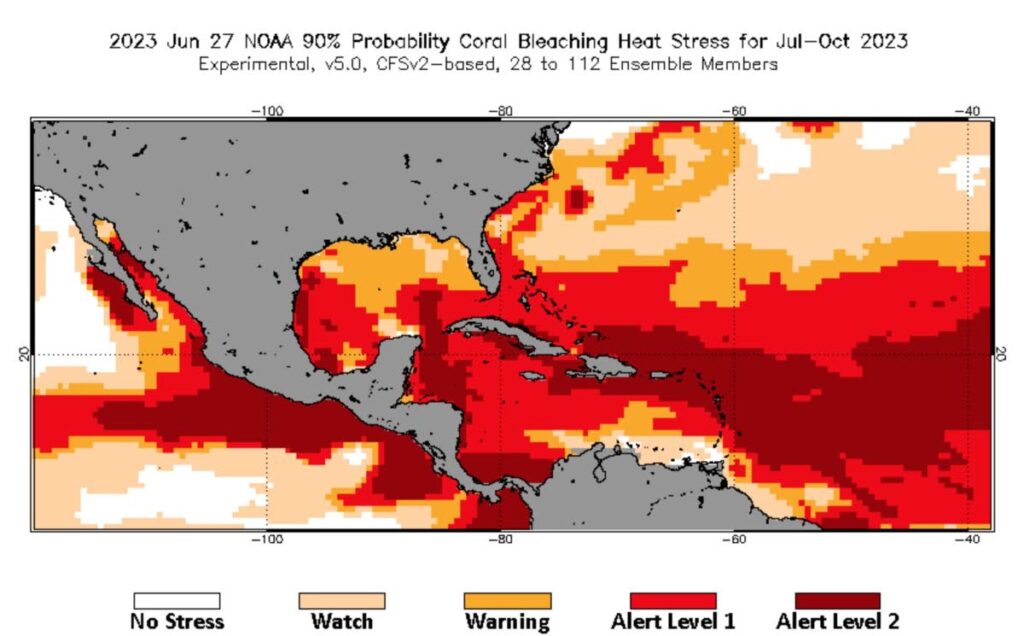Caribbean coral reefs at high risk in 2023

Among the most vulnerable to climate change are tropical coral reefs and the ecosystems that nurture many juvenile fish. Coral reef ecologist Dr Anjani Ganase raises the alarm for severe heat stress over the next months.
Coral Reef Watch (NOAA) for the Caribbean is predicting severe coral bleaching throughout our region from July to October. A bulletin was released in June by the Caribbean Institute for Meteorology and Hydrology using NOAA’s Coral Reef Watch four-month outlook (https://coralreefwatch.noaa.gov/index.php).
What is coral bleaching?
Tropical corals have formed a special relationship with microscopic algae that live in the tissues of corals and give them the vibrant colours we associate with coral reefs. The microalgae photosynthesise using the sunlight and produce enough energy to supply themselves and their coral host. In return, the coral protects the algae from predation and supplies them with essential nutrients and the removal of the algae’s waste. This efficient relationship results in massive reef structures that are utilised by other marine creatures as safe places to live.
The breakdown of the relationship between coral and algae is referred to as coral bleaching, and it typically occurs under stressed environmental conditions, such as when temperatures are too hot or too cold. When there is thermal stress, there is an expulsion of the colourful algae that results in the corals turning white, called bleaching. The loss of the algae means that the corals lose their major source of food; and persistent stressful conditions results in coral mortality. In the last 40 years, coral reefs around the world have suffered from coral bleaching events, where large sections of reef were turning white as summertime sea temperatures became too warm. Coral reefs of Tobago have also suffered from multiple bleaching events – 2005 and 2010 – with major coral loss and limited recovery on both occasions.
Currently, many Caribbean nations are under Coral Watch Level – which means there is a low-level of thermal stress being experienced by the corals. These bleaching alerts have come two months earlier this year starting in June, instead of August as in previous years. There is 90 per cent chance of severe bleaching and heat stress for the wider Caribbean between July and October.
More specifically, Coral Reef Watch is even predicting that much of the region (Greater and Lesser Antilles) will experience Bleaching Alert Level 1 – where bleaching is likely – by August, and by September reef conditions are likely to exceed Bleaching Alert Level 2 – associated with wider spread bleaching and mass mortality of corals. However, most of the marine areas along the Caribbean Central American coast are already at Bleaching Alert Level 2. Coral bleaching has been observed on Belize reefs. Trinidad and Tobago is currently at Warning Level, which means that coral heat stress is accumulating and there are minor observations of bleaching already in Tobago.
This is a significant contrast to the previous three years, when oceanic conditions were cooler owing to the La Niña scenario in the Pacific. This year, El Nino conditions are prevailing bringing much hotter and drier conditions both on land and in the oceans. This is not to say that there was no bleaching observed in Tobago over the last three years. In fact, Tobago has experienced three consecutive years of mild to moderate bleaching at specific sites and for certain coral species. This is a common trend of climate change and global warming, where bleaching is becoming more likely even under cooler La Niña cycles because of rising ocean temperatures, whereas ten to 15 years ago, bleaching would only be observed under El Niño scenarios. Therefore, El Niño conditions for 2023 signals very bad news for corals not just in the Caribbean but around the world.
Death from bleaching or disease
Corals exposed to thermal stress are also vulnerable to disease outbreaks where microbes thrive and infect rapidly under the warming conditions. Scientists have observed spikes in coral disease outbreaks following thermal stress events in the Caribbean. The 2005 and 2010 bleaching events gave rise to the outbreaks of yellow-band and dark spot diseases that target the mountainous star coral and massive starlet coral respectively. In recent years, a virulent and deadly disease called stony coral tissue loss has been plaguing Caribbean reefs. While it is not observed in Tobago yet, it will eventually reach our shores, and warming conditions are likely to encourage its spread.
At the moment, Bleaching Alert Level One is predicted for September for TT coral reefs. While the predictions for us are slightly milder, these predictions are updated weekly in response to the satellite information and changes in trajectory.
The importance of corals to the health of coastal areas and to livelihoods from the sea can never be overstated. The loss of corals will have significant repercussions on our tourism industry and food security as many fish and invertebrates rely on reefs to provide homes. Coral reefs at risk of widespread bleaching should be placed under intensive care management before and in the months after the bleaching event to facilitate recovery. Considering the natural slow pace of coral recovery, restoration mechanisms must be implemented to speed up the rate of recovery; these are necessary as climate change brings more frequent and severe bleaching events.
Reference
https://rcc.cimh.edu.bb/files/2023/06/Caribbean-CRW-Vol8_Issue_1_June2023.pdf
https://coralreefwatch.noaa.gov/satellite/bleachingoutlook_cfs/outlook_cfs.php


Comments
"Caribbean coral reefs at high risk in 2023"